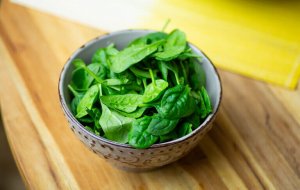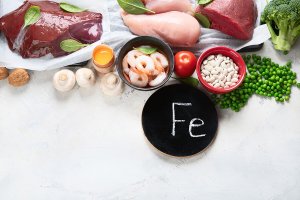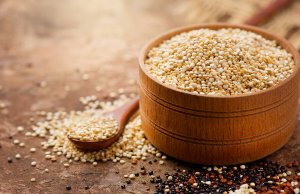How Important is Iron for Physical Exercise?

Your metabolism is an important factor to keep in mind when you exercise. There are many different hormones and nutrients involved which are normally grouped into macronutrients and micronutrients. One of these is iron. But how important is iron for physical exercise? Read on to find out.
Although a lot of people focus on fats and carbohydrates (macronutrients), micronutrients are just as important. Iron is a micronutrient and it’s particularly important for physical exercise and metabolism.
What is iron?
Iron is a light heavy metal which is present in small doses in many foods and supplements. Although you don’t need much iron for vital functions, it’s nonetheless essential. In fact, if you don’t get enough iron, there’s a high chance that you’ll develop a condition known as anemia.
Iron can be found in various forms in the human body, but it’s quite rare to find it free in the bloodstream. Depending on whether it needs to be stored or used, it’s more likely to be found bound to one of two proteins:
- Transferrin: the protein that iron binds to when it needs to be transported to a part of the body that needs it.
- Ferritin: the protein that stores iron. When needed, the iron separates from ferritin and binds to transferrin.
The function of iron in the body
The main, essential function of iron is to supply body tissues with oxygen. Iron is one component of the complex called heme, which is a fundamental part of the structure of hemoglobin and myoglobin.

- Hemoglobin is one of the body’s most important proteins. It’s present in red blood cells and captures and binds oxygen to blood cells as they pass through the lungs. When they pass through tissues, they release this oxygen and for the tissues to use.
- Myoglobin is a fundamental protein in muscle tissue. This protein captures oxygen and allows the muscle to function properly. Muscles tissue needs a lot of oxygen to function.
- It’s also present in liver cytochromes, which are protein complexes that metabolize different drugs and substances.
Heme is made up of a ring-shaped structure called porphyrin, which contains an iron molecule in the center. Heme is responsible for the red color of blood and muscle since it’s found in both in the form of hemoglobin and myoglobin respectively.
Importance of iron for physical exercise
If we look at the basic way that iron functions in the human body, it’s easy to see the importance of iron for physical exercise:
- The right supply of iron ensures the right levels of hemoglobin in the blood. This improves the delivery of oxygen to key exercise tissues such as fat, heart muscle, and striated muscle. Fat tissue needs oxygen to break down fat molecules and provide energy for muscle, which in turn also needs oxygen from the lungs.
- As we noted earlier, iron is also part of myoglobin. As a result, an iron deficiency will cause loss of strength and excessive fatigue, classic symptoms of iron-deficiency anemia.
How to make sure you get enough iron?
Normally, if you stick to a varied yet balanced diet, you’ll have all the iron you need and won’t need any supplements. The exception to this is if you have a genetic condition, which is quite rare, such as thalassemia.
If you do experience symptoms of iron-deficiency anemia, you should speak to your doctor. However, you should be able to avoid this by making sure you include the right foods in your diet. Not only that, but you’ll also achieve better athletic performance.
All of the following foods contain iron:
- Red meats.
- Lentils and other legumes.
- Nuts such as hazelnuts or pistachios.
- Quinoa.

- Almost all seafood.
- Vegetables such as chard and spinach.
- If you’ve had a deficit for a long time, you might consider an iron supplement.
Iron is essential for good health and sporting performance
As you can see, getting enough iron in your diet is really important. It’s essential for vital functions such as tissue oxygenation or the removal of toxic substances by the liver.
And tissue oxygenation is obviously also an important factor when exercising. Getting enough iron will make sure that your muscles work efficiently and you’ll perform better!
Your metabolism is an important factor to keep in mind when you exercise. There are many different hormones and nutrients involved which are normally grouped into macronutrients and micronutrients. One of these is iron. But how important is iron for physical exercise? Read on to find out.
Although a lot of people focus on fats and carbohydrates (macronutrients), micronutrients are just as important. Iron is a micronutrient and it’s particularly important for physical exercise and metabolism.
What is iron?
Iron is a light heavy metal which is present in small doses in many foods and supplements. Although you don’t need much iron for vital functions, it’s nonetheless essential. In fact, if you don’t get enough iron, there’s a high chance that you’ll develop a condition known as anemia.
Iron can be found in various forms in the human body, but it’s quite rare to find it free in the bloodstream. Depending on whether it needs to be stored or used, it’s more likely to be found bound to one of two proteins:
- Transferrin: the protein that iron binds to when it needs to be transported to a part of the body that needs it.
- Ferritin: the protein that stores iron. When needed, the iron separates from ferritin and binds to transferrin.
The function of iron in the body
The main, essential function of iron is to supply body tissues with oxygen. Iron is one component of the complex called heme, which is a fundamental part of the structure of hemoglobin and myoglobin.

- Hemoglobin is one of the body’s most important proteins. It’s present in red blood cells and captures and binds oxygen to blood cells as they pass through the lungs. When they pass through tissues, they release this oxygen and for the tissues to use.
- Myoglobin is a fundamental protein in muscle tissue. This protein captures oxygen and allows the muscle to function properly. Muscles tissue needs a lot of oxygen to function.
- It’s also present in liver cytochromes, which are protein complexes that metabolize different drugs and substances.
Heme is made up of a ring-shaped structure called porphyrin, which contains an iron molecule in the center. Heme is responsible for the red color of blood and muscle since it’s found in both in the form of hemoglobin and myoglobin respectively.
Importance of iron for physical exercise
If we look at the basic way that iron functions in the human body, it’s easy to see the importance of iron for physical exercise:
- The right supply of iron ensures the right levels of hemoglobin in the blood. This improves the delivery of oxygen to key exercise tissues such as fat, heart muscle, and striated muscle. Fat tissue needs oxygen to break down fat molecules and provide energy for muscle, which in turn also needs oxygen from the lungs.
- As we noted earlier, iron is also part of myoglobin. As a result, an iron deficiency will cause loss of strength and excessive fatigue, classic symptoms of iron-deficiency anemia.
How to make sure you get enough iron?
Normally, if you stick to a varied yet balanced diet, you’ll have all the iron you need and won’t need any supplements. The exception to this is if you have a genetic condition, which is quite rare, such as thalassemia.
If you do experience symptoms of iron-deficiency anemia, you should speak to your doctor. However, you should be able to avoid this by making sure you include the right foods in your diet. Not only that, but you’ll also achieve better athletic performance.
All of the following foods contain iron:
- Red meats.
- Lentils and other legumes.
- Nuts such as hazelnuts or pistachios.
- Quinoa.

- Almost all seafood.
- Vegetables such as chard and spinach.
- If you’ve had a deficit for a long time, you might consider an iron supplement.
Iron is essential for good health and sporting performance
As you can see, getting enough iron in your diet is really important. It’s essential for vital functions such as tissue oxygenation or the removal of toxic substances by the liver.
And tissue oxygenation is obviously also an important factor when exercising. Getting enough iron will make sure that your muscles work efficiently and you’ll perform better!
All cited sources were thoroughly reviewed by our team to ensure their quality, reliability, currency, and validity. The bibliography of this article was considered reliable and of academic or scientific accuracy.
- Rubeor, A., Goojha, C., Manning, J., & White, J. (2018). Does Iron Supplementation Improve Performance in Iron-Deficient Nonanemic Athletes? In Sports Health (Vol. 10, Issue 5, pp. 400–405). SAGE Publications Inc. https://doi.org/10.1177/1941738118777488
- Clénin, G. E., Cordes, M., Huber, A., Schumacher, Y., Noack, P., Scales, J., & Kriemler, S. (2016). Iron deficiency in sports – definition, influence on performance and therapy. Schweizerische Zeitschrift Fur Sportmedizin Und Sporttraumatologie, 64(1), 6–18. https://doi.org/10.4414/smw.2015.14196
- Suedekum, N. A., & Dimeff, R. J. (2005). Iron and the athlete. Current Sports Medicine Reports, 4(4), 199–202. https://doi.org/10.1097/01.csmr.0000306207.79809.7f
- Clénin, G. E., Cordes, M., Huber, A., Schumacher, Y., Noack, P., Scales, J., & Kriemler, S. (2016). Iron deficiency in sports – definition, influence on performance and therapy. Schweizerische Zeitschrift Fur Sportmedizin Und Sporttraumatologie, 64(1), 6–18. https://doi.org/10.4414/smw.2015.14196
- Berg, J. M., Tymoczko, J. L., & Stryer, L. (2002). Hemoglobin Transports Oxygen Efficiently by Binding Oxygen Cooperatively.
This text is provided for informational purposes only and does not replace consultation with a professional. If in doubt, consult your specialist.








